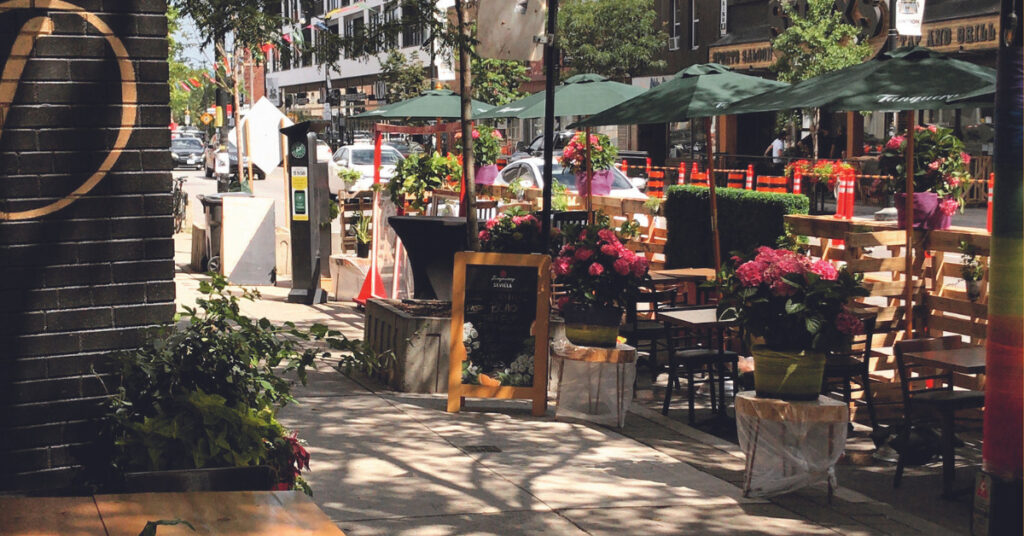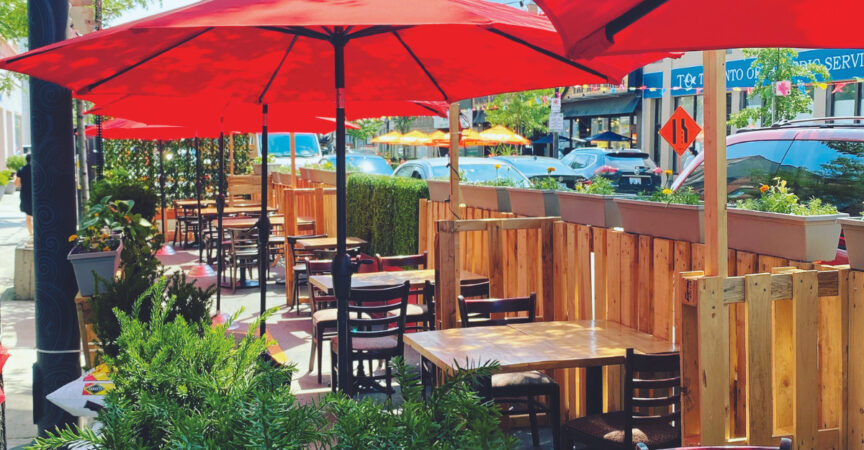It’s Patio Season. Are you ready?
Designing experiences for the elements, the environment and the long-term
The first year Alessia Di Conti Vacca and her husband Fabio Vacca, owners of Decò Ristorante and Wine Bar in the Junction, Toronto, put up a patio for the CaféTO program, they learned a very important lesson: make sure your patio structure is secured to the ground. “There was a windy night and Sunday morning my neighbour called me and said your patio is upside down in the middle of the street,” says Fabio. “After that learning experience we built a patio that was impossible to blow away.” As restaurant owners head into the 2022 patio season, many of them considering a patio for the first time, it’s important to seek guidance and direction on the many uncertainties associated with building and operating a patio, and learn from the experiences of fellow operators.
One thing is for certain: Canadians love their patios. In many places across the country, the outdoor dining experience will begin as early as April and extend well into October, allowing for increased resident occupancy during the summer. With COVID-19 restrictions lifting it’s the perfect opportunity for many restaurants to take advantage of an audience that is eager to return to patios.
Additionally, many city programs that started during the pandemic are becoming permanent, such as the CaféTO program in Toronto which supported over 1,200 restaurants in 2021 and is offering a grant up to $7,500 this year to offset restaurant owners investment costs or the City of Vancouver’s temporary expedited patio program (TEPP) which in 2021 saw almost 700 patios approved throughout the city.
According to David Hopkins, President of The Fifteen Group, a hospitality consulting agency specializing in restaurant operations, “Patios are an easy way to make your existing restaurant operations more profitable. Revenue for restaurants is the most important thing driving profit. If your profit margin on a restaurant is 10 per cent, approximately half of any incremental revenue goes straight to the bottom line. So if you can get another $100,000 of incremental revenue from a patio over the season you’re potentially driving over $50,000 straight to profitability.”
Given the challenges the restaurant industry has been hit with over the last two years, any opportunity to increase profitability is welcome. More operators are realising the value in either expanding their outdoor spaces or improving their existing space. Patios allow for larger capacity throughout the restaurants with additional seating and more dining services throughout the day and night. Patios in particular are often more conducive to drinking alcohol, enabling restaurants to capitalise on higher margins. “When we were in lockdown, many people were searching out restaurants that had patios,” says Nathalie Kent, Communications Manager at The Fifteen Group, “but having a great patio with a welcoming ambiance and excellent service really bolsters a restaurants’ value and offers more revenue streams for owners, resulting in increased resilience.”
Before CaféTO, the Junction was not known for its patios and now, we’re a patio lover’s paradise.” – Matthew Mohan, Operations Manager, Junction BIA, Toronto
“The number one thing restaurant owners can do when preparing for the patio season is to plan,” says Kent. “You need to know what kind of patio will work best for your business and understand the rules and regulations for operating a program in your city or province.” If you’re taking advantage of a government program, give yourself time to choose which patio layout is the best option for your business because the applications will vary based on the kind of patio you want to open. Take time to read over the guidelines and make sure your insurance and business licences are up to date. Most critical – don’t underestimate how much time and work goes into the application process for government programs. For example, CaféTO requires most operators to submit a very specific and detailed site plan as part of the application process.
For Alessia and Fabio Vacca, the local Junction BIA was a big help in navigating the CaféTO program application process. Matthew Mohan, Operations Manager for the Junction BIA is a big fan of the program. “The CaféTO program has been a game-changer for businesses in the Junction in helping them to weather this immensely challenging time. Before CaféTO, the Junction was not known for its patios and now, we’re a patio lover’s paradise. Ultimately, the program not only brings additional promotion and foot traffic to our restaurant businesses, but to all small businesses in the Junction,” he says.
The association also supports restaurant owners by staying in constant communication with their members, ensuring they do not miss any registration and grant deadlines and that they know what to expect out of the program so they can plan accordingly. “We work with CaféTO to ensure that owners are receiving all of the space that they need, and lobby on their behalf when regulations or guidelines require changes,” says Mohan. The Junction BIA has also developed a program that provides their member businesses with complimentary promotion on their websites and via social media – last year’s social media campaign resulted in almost 15,00 impressions. Mohan adds, “We also offer cross functional promotion opportunities via round stickers which will be affixed to all CaféTO patio tables and Muskoka chairs that will be setup through the area. For example if you are eating at a restaurant and scan a QR code, you will be offered a promotion for a neighbouring business.”
On top of the business planning elements, there are a lot of atmospheric and experiential elements that go into building a patio. “Patio dining is all about selling people on the experience”, says Kent. Many of the extended patios are on busy and noisy streets or down alleys, so it can be challenging to try and capture the ambience and intimacy from inside the restaurant.” It was one of the main things Alessia and Fabio considered when building their patio at Decò. “We tried to create a European atmosphere,” says Fabio. “The idea was to give our customers the most comfortable feeling possible.” To keep the patio separate from the noise of the street they built a partition with wooden pallets that went as high as the CaféTO regulations would allow. “When you’re sitting down you don’t see the cars,” adds Alessia, “it is very intimate.” They also used decorations such as flowers and lighting that was consistent with their indoor space.
That perceived sense of separation ensures customers don’t feel like they are eating in the middle of the street. “Barriers can do a really good job of creating that visual break between the patio area and the busy traffic area,” says Kent. “They can be as simple as flower planters which also improve the visual experience of the customer.”

Other patio best practices The Fifteen Group suggests restaurants implement are multi-levels of lighting, incorporating table decor and pillows for comfort, considering weather protection measures such as the use of umbrellas or awnings for sun protection and cover from the rain and heaters and blankets for those colder nights. Having a bad weather back-up plan is also important. “All of these elements will not only make the customer experience more enjoyable,” says Kent. “But customers will seek you out again in the future.” Another contributor to a successful patio is robust signage and wayfinding. Patios are generally a more transient space and require guests to navigate a little more actively. Kent recommends setting yourself up for success by communicating effectively with your guests. “Simple things like making sure they know where they should wait to be seated will not only make life easier for your staff and servers, it makes it a better experience for your customer to know what is expected of them and where to go.” An often-neglected but very important consideration when building a seasonal or temporary patio is removal and storage considerations. Rentals can be a great option because you don’t have to figure out the offseason plan or storage strategy.
Accessibility is another key element operators need to keep in mind when designing a patio so that people with mobility challenges are also able to enjoy the outdoor experience. Ensure you have wide patio entrances (one metre or more) to accommodate a wheelchair or mobility device. If your patio is raised or lowered from street level, a ramp will be required and it’s always worthwhile to confirm all accessibility regulations with local government entities. In terms of more general design for accessibility, make sure you have furniture that can be easily moved or shifted and offer flexible seating to accommodate guests with mobility concerns.
Arguably the most important part of the patio customer experience is service. “Ten out of ten service is what will set you apart,” says Hopkins. “With a patio, restaurants must remember to stay focused on the core of what makes a restaurant successful: guest experience is the number one thing that drives repeat customers.”
Consider your patio menu and engineer it for the environment by focusing on items that are quick to execute. Include lots of sharable options that are conducive to groups on patios where the focus is more on drinking and snacking than individual plates. Consider how well your menu travels, if it’s practical for a server to be making more than one trip per table and how to minimize the back and forth.
Patios are a great place to leverage technology such as QR codes for menus or incorporating software that allows you to have a digital menu that customers can order directly from and pay through. Make sure the checkout experience is efficient by placing plenty of remote POS machines on the patio for servers to leverage for quick service.
Guarantee your patio is set up for optimal service by developing a functional layout. Setup stations on the patio that hold cutlery and linens and place self-serve water pitchers and condiment caddies on the tables. “Incorporate lots of smaller group seating options as opposed to larger tables to maximize your seating and thru-put,” recommends Kent. Make sure your staff is trained and supported on the patio. Meet with your team ahead of time so everyone understands who’s going to be in charge of what and what the expectations are to successfully manage the flow operationally.
Finally, be a good neighbour. Many of the extended patios are on properties that may impact neighbouring businesses. “Remember that you’re representing your brand so make sure that you’re a good neighbour,” says Hopkins. “How your neighbours and how the community sees you is really critical to your long-term success.” Be noise-considerate and sensitive to congestion, right-of-ways and flow of pedestrians who are not necessarily on your patio but may be going to a store on either side of your restaurant. “In the Junction we encourage restaurant owners to share their space during their off-hours with retail and service neighbours if possible,” says Mohan. “It’s a perfect opportunity for them to make use of the space to promote their own business.” Neighbourhood restaurants and bars are a big part of the community, so ensure that you take that into account when you develop your patio and execute your service.
For Alessia and Fabio, the patio season couldn’t come fast enough and they are well into their 2022 patio planning, focusing on that secure patio base and adding even more decor. “It’s a beautiful experience for us,” says Fabio, “especially in the summer, at night, with a nice breeze and the lights and the music. You feel like you’re somewhere else and that’s the whole idea.” Adds Alessia, “and wine always helps.”







